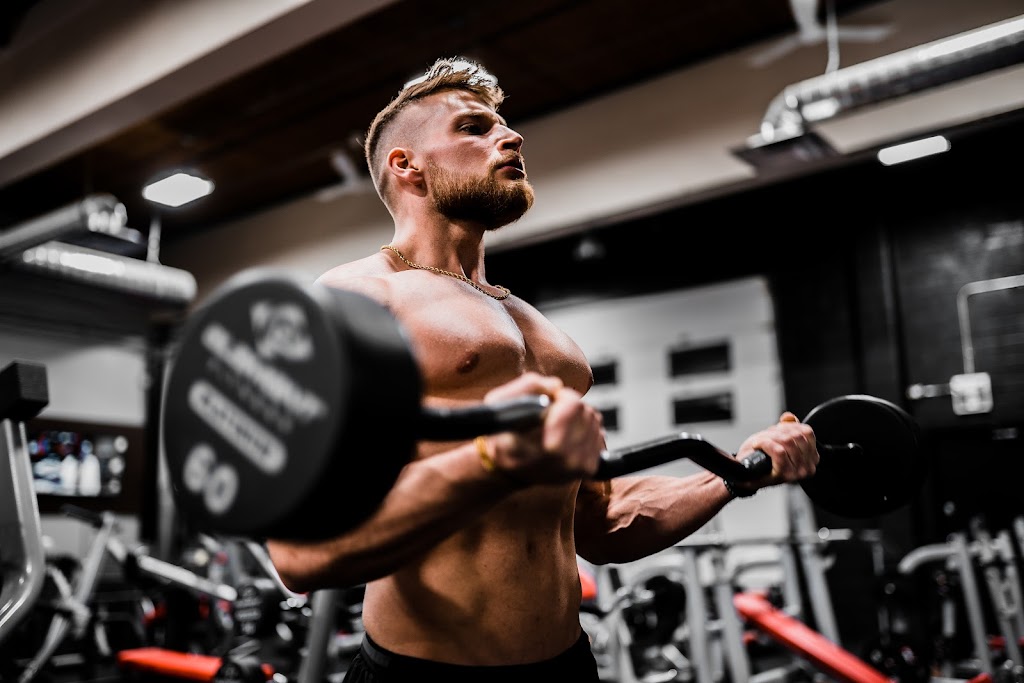When you’re training grip intensive exercises like chin-ups, deadlifts, bent-over rows, or carry variations, you will often feel your forearms burning. It’s usually the first muscle group to fatigue, and so grip strength is often a weak point for many lifters. When ripping a 500-pound deadlift off of the ground, it’s almost always your grip, not your lats, that give out first.
Of course, you can throw a bandage on the issue and wear lifting straps (which are a great tool), but you should also focus on building forearm strength. Below, we outline the best forearm exercises, dive deep into the benefits of forearm training, and explain how your forearm muscles function.
Best Forearm Exercises
- Barbell Reverse Biceps Curl
- Wrist Roller
- Behind-The-Back Barbell Wrist Curl
- Plate Pinch
- Towel Pull-Up
- Fat Grip Biceps Curl
- Three-Way Chin-Up Hold
- Trap Bar Deadlift to Carry
- Hammer Curl
- Bottoms Up Kettlebell Carry
Barbell Reverse Biceps Curl
The simple act of changing your grip on the barbell curl will help you build size and strength on the neglected part of the forearm. Reverse curls train the smaller forearm extensors (brachioradialis, pronator teres) and brachialis — a muscle underneath the biceps that will help make your biceps look bigger when you flex. Strength imbalances between the forearm extensors and flexors may lead to sore elbows, so it pays to train the forearm extensors from an injury prevention standpoint too.
Wrist Roller
This is a great forearm exercise because it builds size, strength, and endurance simultaneously. The wrist roller trains both forearm flexors and extensors (deltoids and rotator cuffs isometrically), and the pump and burn are incredible while using only light resistance. The wrist roller is one of the best exercises for developing forearms, and it is a vital piece of equipment in any gym. The downside is, if your gym doesn’t have one, then you’re out of luck.
Behind-The-Back Barbell Wrist Curl
The behind the back wrist curl targets your forearm flexors and improves your finger strength. Both are important for grip strength and improving your ability to grip it and rip it. A major advantage of this variation, as opposed to other options, is adding load in increments. Start on the lighter side with higher reps, but don’t be afraid to add weight to strengthen your forearms further.
Benefits of the Behind-The-Back Barbell Wrist Curl
Isolates the forearms flexors with a load higher than other wrist curl variations.
The ability to add incremental load.
Improves finger and grip strength.
Plate Pinch
Your fingers are incredibly strong — strong enough for some people to climb mountains while supporting their entire weight with a few fingertips. While a lot of grip exercises use a crush grip, the plate pinch trains the pinch grip, getting the fingers, thumbs, and forearms strong. This is a great exercise for football players and wrestlers to improve their sport-specific grip strength.
Towel Pull-Up
When regular pull-ups become easier, the simple act of adding a towel will make this exercise tougher because it’s harder to grip a towel than a bar. This version focuses on the forearms because of the neutral grip and the difficulty of holding and pulling up on the towel, which builds forearm strength and size while strengthening your back and biceps.
Fat Grip Biceps Curl
The fat grip biceps curl makes the dumbbells harder to grip by increasing their diameter, forcing your forearms and biceps to work harder. This trains the forearms in two ways, by engaging your hands through gripping and your forearm by flexing. You have the benefit of either using a supinated grip, hammer curl grip, or reverse grip, depending on your goals. If you need to increase grip strength and get some Popeye forearms and biceps, this one is for you.
Three-Way Chin-Up Hold
The three-way chin-up hold strengthens your grip in three different positions. It also helps you improve your strength and performance with regular chin-ups. The isometric holds in each position test your forearm and grip strength by increasing your time under tension for potential forearm hypertrophy benefits. This exercise is a true test of will, and doing it will build mental and physical toughness.
Trap Bar Deadlift to Carry
Deadlifts strengthen your posterior chain and improve your ability to produce force and power. The carry portion can train your shoulder stability, core strength, and grip strength. It can also add some beef to your forearms. Put them together to produce both muscle and pain. Trap bar carries not only tear up your grip but also allow you to use more weight for better forearm strength and hypertrophy.
Hammer Curl
Yes, another biceps curl made the list — but for good reason. The neutral grip of the hammer curl variation is friendlier on your elbows and shoulders than other curl variations. Plus, the neutral grip leads to extra recruitment of the forearm muscles and the important but neglected muscle the brachioradialis. This muscle stabilizes the elbow joint during rapid flexion and extension — which is handy if you throw for a living or in recreation. Because the neutral grip is a stronger lifting position, you’ll potentially lift more weight than other curl variations.
Bottoms-Up Kettlebell Carry
Holding a kettlebell bottoms-up is simple but not easy. The bottoms-up kettlebell carry will challenge your grip and forearm strength. You’ll flip the kettlebell upside down so the heavy portion sits above the handle and the horn sits on the meat of your hand. This forces you to recruit additional muscle fibers and motor units to control the unstable load. Bottoms-up carries can improve your posture, lateral stability, grip, and forearm strength while strengthening the entire shoulder joint.


